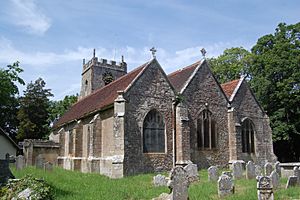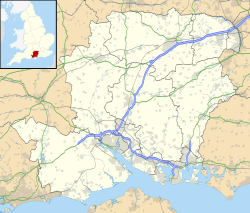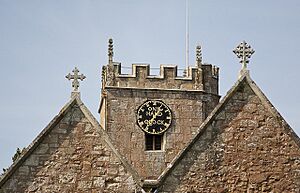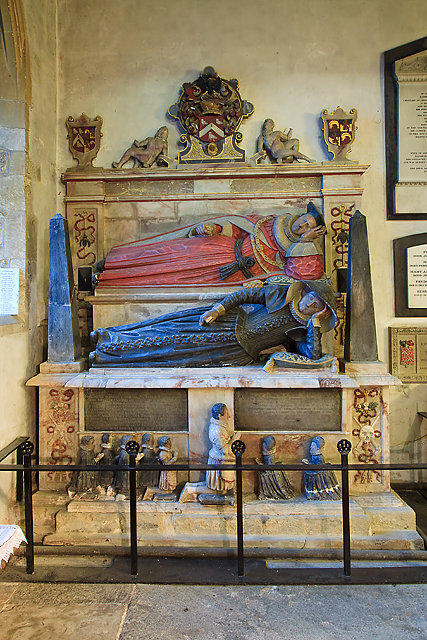St Nicolas Church, North Stoneham facts for kids
Quick facts for kids St Nicolas Church, North Stoneham |
|
|---|---|
| St Nicolas Parish Church | |

The church from the southeast
|
|
| 50°57′13″N 1°22′26″W / 50.9535°N 1.3740°W | |
| Location | Stoneham Lane, North Stoneham, Hampshire |
| Country | England |
| Denomination | Anglican |
| Website | nsab.org.uk |
| History | |
| Status | Parish church |
| Founded | 15th century |
| Dedication | St Nicolas |
| Architecture | |
| Functional status | Active |
| Heritage designation | Listed building - Grade II* |
| Architectural type | Church |
| Style | Gothic survival |
| Specifications | |
| Materials | Ashlar |
| Administration | |
| Parish | North Stoneham and Bassett |
| Deanery | Southampton |
| Archdeaconry | Bournemouth |
| Diocese | Winchester |
| Province | Canterbury |
St Nicolas Church is an Anglican parish church located in North Stoneham, Hampshire. This historic church was built before the 15th century. It is well-known for its unique "One Hand Clock," which dates back to the early 17th century. The church also features several important memorials to famous people.
Contents
Where is St Nicolas Church?
The church stands on Stoneham Lane. It is located at the edge of the old Stoneham Park. Experts have described its setting as "rural isolation." It sits in a green area between Eastleigh and Southampton.
History of the Church
Early Beginnings
The area of North Stoneham has a long history. It was known as "Stonam Abbatis" in the early 9th century. This means "Abbots Stoneham," and it was connected to Hyde Abbey in Winchester. Back then, the parish was much larger. It stretched from the River Itchen in the east to Chilworth and Bassett Green in the west. Today, North Stoneham is part of a larger parish with Bassett. St. Nicolas is one of three churches serving this area. The others are St. Michael & All Angels and All Saints.
Building and Changes Over Time
St. Nicolas Church is very old, dating back to medieval times. People believe it has been a place of worship for about 1,000 years. It is a Grade II* listed building, which means it is a very important historical site. Records suggest it was built on the site of a 13th-century church. There might have even been a Saxon chapel there before that.
The church was rebuilt between 1590 and 1610. This was around the time the Fleming family bought the estate. The new building used an "interesting Gothic survival manner." This style kept older Gothic features. The church was repaired in 1826 by Thomas Hopper. It was restored again in the late 19th century by George Bodley. A new vestry, which is a room for clergy and church items, was finished in 2008.
The Lych Gate
The lych-gate was built in 1909. It was made to remember Emily Macarthur. She was the wife of James Macarthur, who was the Bishop of Southampton at the time. The gate was designed by Isle of Wight architect Percy Stone. It was built using oak wood from HMS Thunderer. This ship famously took part in the Battle of Trafalgar.
Outside the Church
The church has a unique look. It has three gables at the east end and a tower at the west. It features ashlar stone walls and buttresses. A 13th-century window is in the western wall of the tower. This window has three lancets, with the middle one being taller. It was likely the east window of an earlier church. It was reused when the tower was built around the 16th century.
The east window of the chancel is from the 15th century. It has three lights with tracery. The windows in the north and south aisles are from the 16th century. They have been repaired many times. The north aisle has four windows. One is pointed, and three are square-headed. There is also a round-headed doorway. The south aisle windows are all square-headed. The roof has red tiles and three sections. The vestry, built in 2008, is at the church's southwest corner.
The Tower and Bells
The church tower is made of ashlar stone. It has two tall sections with bell openings. It also has battlements and thin pinnacles. An octagonal stair turret is on the northeast corner. The tower dates from about 1600.
St. Nicolas Church has a long history of bell ringing. The church has ten bells. They were once the lightest set of ten bells in the country. The bells are held on two frames, one above the other. Part of the lower frame is from the 17th century. This was when the first bells were installed. In 1908, it was reported that the church had six bells from 1893. Before that, there were three older bells. Of the current bells, three were made in 1931. The other seven were made in 1956. In 2006, the church raised money to fix the bell-frame. They even had a Teddy bear parachute jump to help!
The One-Handed Clock
On the east side of the tower, you can see the church clock. It is special because it only has one hand, which points to the hour. This "One Hand Clock" was first put in place in the early 17th century. The clock's mechanism was made by William Monk. When the clock was first installed, people mainly counted time in hours, not minutes.
The clock has been restarted many times. Its movement was last fixed in 1995. Local groups helped to restore and maintain the clock.
Inside the Church
The church has a chancel that is about 7.6 meters long and 4.6 meters wide. The nave is about 10.9 meters long. The aisles run the full length of the nave and chancel. They are about 3.5 meters and 3.4 meters wide. The tower is about 3.0 meters by 2.9 meters.
The aisle walls are made of ashlar stone. They are mostly in the Perpendicular style. The east wall of the chancel is older. It is believed to be part of the medieval church. The nave arcades have three bays with octagonal pillars. These are likely from the 15th century. Two of the pillars are Early English in style.
The organ is at the east end of the north chancel aisle. It was made around 1935 by the Positive Organ Company. It was renovated in 1974 and 1993. The 15th-century font is under the east arch of the tower. It has an octagonal bowl made of Purbeck marble.
Windows and Porch
The church once had special windows from 1826. They showed the family history of the Fleming family. These windows were shattered by a bomb during the Second World War. The broken pieces have been put back into the windows.
For a while, the porch held two memorial panels. These panels honored those who served in the First World War. They were made by the artist Eric Gill. They were moved to the church from the Stoneham War Shrine during its renovations. They were returned to the War Shrine when its repairs were finished in 2010.
Important Memorials
Slavonian Tombstone
On the chancel floor, there is a gravestone for Slavonian merchants. It is a bluish limestone slab. It has a shield with a double-headed eagle. Around the edge, there is an inscription in Latin. It says, "The Burial Place of the Guild of Slavonians."
This tomb dates back to the 15th century. At that time, a large fair was held in Winchester. It was one of the biggest fairs in Europe. Foreign merchants, including a group called the "Guild of Slavonians," attended this fair. In 1491, they bought a vault in North Stoneham church. This was for any of their guild members who died in England. In 1499, highwaymen attacked their trade convoy. Two of their members were killed, and they were buried here.
William Erasmus Darwin (1839–1914) is also buried in the church. He was the eldest child of the famous naturalist Charles Darwin.
Lord Hawke's Monument
In the south aisle, there is a detailed memorial to Admiral Lord Hawke. It shows a scene from the Battle of Quiberon Bay (1759). Lord Hawke was a very important naval leader. He died in 1781 and chose to be buried with his wife. His son, the second baron, put up this beautiful white marble memorial in 1783. It was carved by sculptor John Francis Moore. It includes a bas-relief of the painting "The Battle of Quiberon Bay."
In November 2009, the church held special events. These marked the 250th anniversary of the Battle of Quiberon Bay. There is also a memorial to Lord Hawke's wife, Catherine.
Sir Thomas Fleming's Monument
At the east end of the south aisle, you can find the monument to Sir Thomas Fleming. He was a Lord Chief Justice. He was one of the judges at the trial of Guy Fawkes in 1605. Sir Thomas died in 1613. This memorial is known as "the floating Flemings." It shows Lord and Lady Fleming lying on their sides. They are wearing their court robes. Kneeling figures of their six sons and two daughters are also shown. The monument has an inscription that tells about Sir Thomas's life. It mentions his important roles and his family.
There are many other memorials to members of the Fleming family. These include monuments to John Fleming (died 1802) and John Willis Fleming (died 1844).
The Church Today
Even though it is in a rural area, the church has a dedicated group of people who attend services. Regular Sunday morning and afternoon services are held.
Clergy
The clergy serve all three churches in the Parish. These are St Michael and All Angels, St Nicolas, and All Saints' Church, Bassett. The most recent Rector, the Reverend Sheena Williams, started her role on February 3, 2017. She grew up in Linlithgow, Scotland. She studied law before becoming a priest in 2010. She now shares her ministry among the three churches.
Stoneham Rectory
The 19th-century rectory is across Stoneham Lane. It is also a Grade II listed building. Today, it is part of an office complex. The old gateway to the rectory is also listed as Grade II.





